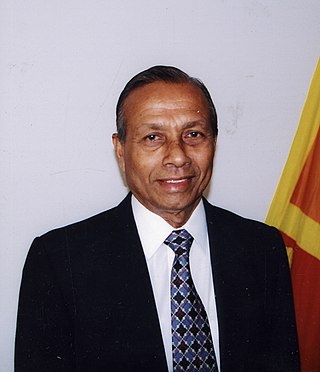The "Sri Lanka Matha" is the national anthem of Sri Lanka. "Sri Lanka Matha" was composed by Ananda Samarakoon and was originally titled "Namo Namo Matha".

Ratnasiri Wickremanayake was a Sri Lankan politician who served as Prime Minister of Sri Lanka from 2000 to 2001 and again from 2005 to 2010, and also served as the Leader of the Opposition from 2001 to 2002. He was a Member of Parliament representing the Horana electorate and later the Kalutara District.
The Suriya-Mal Movement was formed in the British colony of Ceylon to sell Suriya flowers on Poppy Day for the benefit of Sri Lankan ex-servicemen. The movement became anti-imperialist in character, and was also involved in relief work during the Malaria epidemic of 1934–1935.

Patrick de Silva Kularatne was a Sri Lankan educationist and politician. He was a Member of the State Council of Ceylon (1942-1947) and Member of Parliament (1960-1965). He served as Principal of Ananda College and Dharmaraja College and established Nalanda College Colombo, Ananda Balika Vidyalaya, Moratuwa Vidyalaya and Dharmapala Vidyalaya. As a member of the executive committee on Education, he played an instrumental role in the realisation of free education from kindergarten to university.

Ranasinghe Hettiarachchige Tudor Edward Ranasinghe Gunasekara, commonly known as Tudor Gunasekara, was a Sri Lankan politician and diplomat.
Horana is a town in Kalutara District, in the Western Province of Sri Lanka. It is on the A8 highway between Panadura and Ratnapura, 50 km (31 mi) away from Ratnapura and 18 km (11 mi) away from Panadura. Horana is connected with Colombo via B84 Colombo - Horana road, 42 km (26 mi) away from Colombo

Alexander Perera Jayasuriya was a Ceylonese politician. He was a Minister of Health, Senator and Member of Parliament. He was one of the founders of the Sri Lanka Freedom Party.
The urban campus of University of Colombo is located in Colombo, Sri Lanka, primarily situated around Cinnamon Gardens.
The University of Colombo currently has seven faculties with 41 academic departments and two interdependent schools with five academic departments. All faculties and schools carries out courses of study and research in both graduate and undergraduate studies. In addition, the university has several institutions that specialize in different areas of research.

The Sri Palee Campus of the University of Colombo is located in Wewala, Horana, Sri Lanka. Established in 1996 it conducts undergraduate and postgraduate courses in the fields of performing arts and mass media.

Wilmot Abraham Perera (1905–1973) was a Sri Lankan statesman and philanthropist. He was declared a National Hero in 1993. A member of parliament, he was Ceylon's first Ambassador to China.
Deshabandu Indradasa Hettiarachchi was a Sri Lankan politician and the former Minister of Industries.

Wilmot Arthur de Silva was a Ceylonese veterinary surgeon, politician and philanthropist. He was the Minister of Health (1936–1942) in the second State Council of Ceylon and a former President of the Ceylon National Congress.

Henry Woodward Amarasuriya was a Ceylonese plantation owner, politician, educationist and philanthropist. He was the Cabinet Minister for Trade and Commerce in the cabinet of D. S. Senanayake. A former member of the Ceylon state council, H. W. Amarasuriya was a founding member and the first general secretary of the United National Party. He also held the position of Deputy Speaker and Chairman of Committees in the first parliament of Ceylon. A member of the first Education Executive Committee of the state council and a former general manager of the Buddhist schools, he did a great service to improve the education in Ceylon.
H Cannappen Velusingham Velupillai was a Ceylonese trade unionist, politician and poet.
Bernard Soysa was a Sri Lankan politician.
William Bandara Makuloluwa, , popularly as W. B. Makuloluwa, was a folk music composer, promoter and director of theater and film in Sri Lanka. Considered as a legend in Sri Lankan folk music history, Makuloluwa is the pioneer to introduce "Jane Gee" folk music in popular culture. He was also a talented speaker, scholar, Kathakali and Manipuri dancer as well as a songwriter.
Kongahakankanamage Don David Perera was a Ceylonese planter, businessman and politician.
Karunaratne Premathilake, popularly known as Meemana Premathilake was a prominent Sri Lankan poet, journalist and a writer. One of the most respected poets in Colombo era, Premathilake is notable as the founding editor of Sri Lanka's premier artistic newspaper 'Sarasaviya'.
Palihawadana Arachchige Cyril Perera, popularly known by his stage name Aruna Shanthi, was an actor and playback singer in Sri Lankan cinema.









